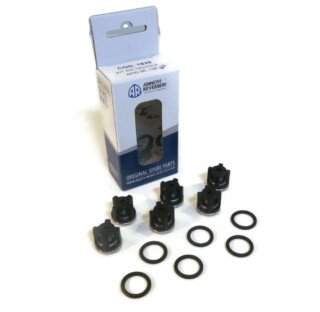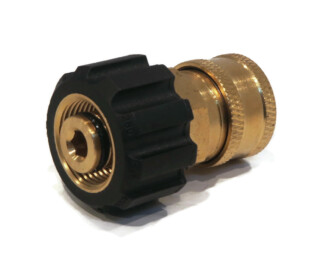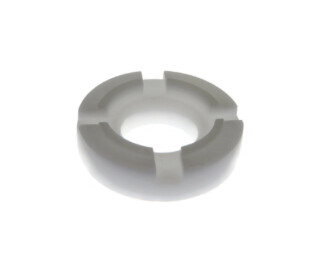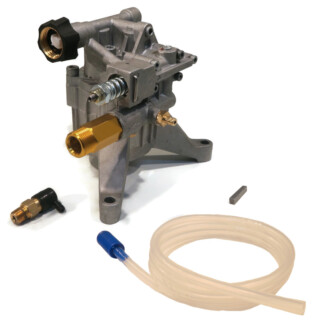
Pressure Washer Pump Troubleshooting Guide
Having some issues with your pressure washer pump?
Your pressure washer isn’t much help to you if it loses pressure. After all, the “pressure” part is the main appeal.
The issue may lie with your pump. Although that may initially sound like you’re in for a complicated (and expensive!) repair, there are some simple fixes you can try first.
Here is a list of 7 troubleshooting tips to help you get your power washer running again.
1. Verify fitment
2. Check the keyway
3. Check your spray tip
4. Inspect for leaks
5. Check engine horsepower
6. Adjust unloader valve
7. Check water temperature
We’ll walk you through each of these items to help you fix the issues with your pressure washer pump. However, if none of those steps seems applicable to your situation, feel free to check out our other pressure washer troubleshooting blog, which covers a wider variety of issues.
1. Verify Pressure Washer Pump Fitment
This might seem like a no-brainer, but you would be surprised how tricky it can be to make sure you’re getting a replacement pump that’s designed to work for your pressure washer.
Shaft diameter and orientation are extremely important to check when purchasing or installing a replacement.
Check our fitment chart to make sure your replacement pump is the correct one for your equipment.
2. Check the Pump’s Keyway

If your washer isn’t producing any pressure, it’s possible your key might have been nudged out of place during installation. Without the key engaging the engine shaft, your pump won’t function.
To check this, remove your pump. You can use the video here to help you.
If your key wasn’t in place while your engine was running, make sure you inspect the pump’s shaft allowance for any signs of damage before reinstalling.
We usually recommend putting a small dent in one side of the key. Do NOT use tape or any other glue/adhesive. Denting it will wedge it in the engine shaft groove, and the key won’t shimmy up the shaft when you slide the pump on.





3. Check Your Spray Tip
Even veteran pressure washer users might not know that the pump isn’t what gives you a powerful spray.
The pump is just a device to force water through a size restriction (i.e., the nozzle/spray tips). The amount of force and the narrowing of the restriction create a given amount of pressure. Because of this, spray tips can wear out quickly.
Make sure you keep some spares on hand, and if your washer suddenly loses pressure, try swapping out tips. This will solve your problem about half the time!
(Want some more handy pressure washing tricks you can use on the job? Check out these 11 tips for DIY pressure washers.)
4. Inspect for Leaks in Your Pressure Washer
Any leaks, obstructions, or damaged O-rings can significantly impact the amount of pressure your pump can produce.
Check your wand and pressure hose, starting from the spray tip and moving backward. Then check your garden hose and the connection to the water supply.
Fix or replace any leaking hoses or O-rings and then apply thread sealant, if needed, at your connections.
5. Check the Engine Horsepower (HP) of Your Washer
If your engine is bogging down or stalling, you can check to see if the pump you purchased is producing more pressure than your engine can handle. If the max PSI (pounds per square inch) for your pump is too much for your engine's horsepower, you can run into trouble.
We usually recommend you stick to the following guidelines when purchasing a replacement pump:
6.5 max HP = 3600 max PSI or less
6 max HP = 3100 max PSI or less
5.5 max HP = 2800 max PSI or less
5 max HP = 2600 max PSI or less
4.5 max HP = 2400 max PSI or less
If your replacement pump is over the max PSI recommendation for your power washer engine, you might be able to adjust the unloader valve down to a PSI rating that is better suited for it. Just follow the adjustment instructions in the last paragraph of Step 6.





6. Adjust Your Pump’s Unloader Valve
Did you purchase one of our Himore brand pumps? If so, it came with an adjustable, spring-style unloader valve. Usually, the pump comes pre-adjusted to the halfway point between the minimum and maximum pressure. If you need to change the pressure setting, follow the directions below.
Please note: All pressure adjustments require holding the HEX head bolt on the tip of the unloader valve while adjusting.
Not enough pressure? Tighten the silver 17mm adjustment nut ¼ turn. Tighten the gold 10mm nut to hold the adjustment nut in place. Check the pressure and repeat if necessary. You can complete two full turns in if needed, but not more.
Too much pressure? Loosen the gold 10mm nut. Loosen the silver 17mm adjustment nut ¼ turn. Tighten the gold 10mm nut to hold the silver 17mm adjustment nut in place. Check the pressure and repeat if necessary. You can complete two full turns out if needed, but not more.
7. Check Water Temperature
If your pressure washer’s pump is overheating, there are a couple of potential causes.
Do you have a hot and cold outdoor water faucet? If so, make sure you’re using cold water only. Also, if your hose has been lying in the sun for a while, the water inside could be too hot for your pump. Before hooking your garden hose to your pump’s water inlet, turn the faucet on and let the water flow until it’s cool.
The second reason your pump could be overheating is because you’re leaving it in bypass mode for too long. Your pump is auto-cooled by the water flowing through it. If there’s no water flow, there’s no cooling action. To correct this, squeeze your spray trigger and get the water flowing every sixty seconds.
Conclusion
The above were some of the common problems with pressure washer pumps, but it could be you're a special case.
If you’ve followed all the above troubleshooting tips for your pressure washer and you’re still not getting the performance you were expecting, please feel free to contact our customer service team. Send us an email, chat with us on our website, or give us a phone call.
You can also check out our other pressure washer troubleshooting blog or our Rugged U video that covers a few extra troubleshooting tips.
If you need to start from scratch with a new unit, check out our pressure washer purchasing guide. Or, if you decide just to replace your pump, we have a guide to help you find a compatible replacement pressure washer pump.
Ready to go pro with your pressure washing? Read these tips for how to market your pressure washing, lawn care, or snow removal services (for free!).
WRITTEN BY: KATE HUFFMAN [EDITED 2/2023]

Having trouble using your ROP Shop pressure washer surface cleaner? These tips can help you out.

Thinking about getting a pressure washer? Here are eight advantages to owning a pressure washer to help convince you.

Installing a new pressure washer pump doesn’t have to be a hassle. Let The ROP Shop walk you through it.

Ready to learn how to pressure wash quickly, effectively, and safely? Check out these eleven tips.